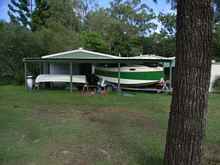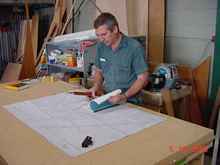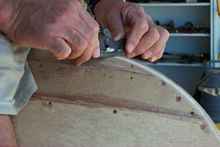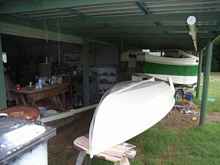| A month or so ago I found myself
sitting under the roller-door of my main shed, cup of black coffee
in hand, watching the rain pour down onto our small country property.
The feeling was good, as I had only just completed a three metre-wide
lean-to across the shed doors, giving an extra twenty-seven square
metres of sheltered space, and I was enjoying the cave-like protection
from the welcome rain.
Compared with big industrial sheds, the little addition was modest
– but my wife and I had constructed it with our own hands,
and the resulting satisfaction and utility was out of all proportion
to the small size of the structure. As the summer rain tumbled
down, I was able to luxuriate in the knowledge that the collection
of boats and tools outside the shed doors were dry and, if I felt
that way inclined, work could continue.
 |
Pleasant working conditions... |
In front of the shed stood a Phil Bolger-designed Micro which
I had built for a customer-turned-friend nine years earlier. She
was there for some minor modifications and I was able to observe
evidence of the standards I employed nearly a decade in the past.
It gave me pause for reflection…
Beside the Micro, a twelve foot lapstrake (clinker) sailing dinghy
rested up-side-down on saw horses waiting patiently for a couple
of dabs of paint on some scratches. This boat was built by one
of my sons when he was just a fourteen-year-old boy – he
will be twenty-three at his next birthday, but the boat is strong
and functional – testament to a young fellow who used his
brain and did the job properly the first time around.
Around the corner stood another Phil Bolger design called Bee.
This was another example of work from the distant past, having
been built twelve years earlier as an interesting toy for my three
sons. I built her in the evenings at a time when my life was very
different – a stressful job, a big mortgage, young family,
busy city life – but the boat was finished and used in countless
children’s adventures. Nephews, nieces, in-laws, friends,
and even me – we all gained pleasure from this tiny boat,
and here she stands against the shed waiting for her next operation
on a creek, lake, or ocean. Her simple hull shows evidence of
past action, but she ages gracefully, which is something difficult
to say about a ‘glass or alloy production boat.
 |
Bee providing fun and education |
The rain continued to pour down, and by this time I had been
joined by my wife and as the light faded we traded the coffee
mugs for wine glasses and some pleasant red. Our recent workload
had been high, and the construction of the lean-to had been physically
demanding, so the opportunity to relax and listen to the drumming
of the rain on the metal roof was a pleasure difficult to properly
describe.
Behind us, the building shed was filled with the clutter and
dust of wooden boatbuilding - scattered tools, sheets of plans,
a boat under construction, and a couple of possums peeking out
from their daytime hiding place in the rafters.
All of what I have just described paints the current stage of
an odyssey I first set out on ten years ago, and I make mention
of it for those of you who may be feeling what I had been suffering
in the lead up to a fateful day in early July of the year 2000.
I’ve been obsessed with hand-built wooden boats since childhood,
but the realities of career and family-life meant that most of
my building activities were spread very thinly over the years.
However, I was always able to make time for reading, and my library
of boating books increased steadily over the years - it was obvious
that the obsession was not going to go away anytime soon.
It is difficult to say just when I made my final decision to
commit to boatbuilding in a serious way, but I do clearly remember
one afternoon when I was all dressed up for a shift in the operational
career I had been committed to for twenty-five years. I had five
minutes of spare time before setting out on my city commute, and
I used that time to cut out a plywood part on the bandsaw for
a boat I was building. I can clearly remember saying to myself
that this is what I really wanted to be doing, regardless of money.
To cut what could be a very long story short, I resigned my respectable
and well-paid job to follow my own star as a full-time boatbuilder.
Now, ten years down the track I can look back on an unbelievable
adventure, and I thank my luck stars that I decided to make the
jump.
 |
Early days in a self-made career |
Things have certainly changed for me, and for my family. As expected,
I now have less money, but I have become an officially trade-qualified
boat-builder, and more than fifty new boats have come through
the doors of my various sheds, along with countless smaller repair
and construction jobs. All of this could not have been achieved
without the help and support of many, many people of high-quality
– family, friends, suppliers, designers, and customers -
but it has been done, and my blood runs cold to think that I could
have so easily missed out on the adventure if I had remained in
my previous job.
Please do not think I am encouraging everyone to chuck in their
existing job to become a penniless hippie. All I am saying is
that I was able make the change and have survived by the skin
of my teeth, and that for me it was, and continues to be, worthwhile.
People must make their own decisions in life, but if you are someone
who is currently questioning your path, and you have a real passion
for boats, it may be worth the jump…
 |
Work never stops |
So, what has been the downside for me? Well, first and foremost,
it has been HARD WORK! There is a certain amount of romance in
being creative in the boatshop, but about 97% of it is just plain
dusty, noisy, monotonous and tiring labour. Other negatives are
that I’ve spent countless hours answering emails, letters,
‘phone calls and personal visits – followed by doing
the inevitable paperwork associated with running a small business
which cannot afford administrative help.
But the upside? I’ve learnt more about my passion than
I could have learnt in several lifetimes of part-time study; my
life has been immeasurably improved because of the people who
have come into it as a direct result of the boat-building and
designing; I can go to my grave knowing that I gave it a go instead
of just wondering; I’ve had the rare privilege of having
made my hobby into my career.
These days I’m doing less building and in its place doing
more design work. This has been part of an on-going evolution,
and is very exciting. Where it will lead I do not know, but I’m
enjoying the ride.
My sort of building and designing still centres around small
boats – anywhere between eight feet and twenty-six feet
long – and I strongly favour boats which are very simple
in structure and rig. Strangely, simple boats are not necessarily
simple to design, and there is a huge difference between the best
and worst examples of simple design on the market. The very best
designs are often quite difficult to properly appreciate, and
may not appear to be that much different from the lower-quality
members of the crowd.
When it comes to simple-to-build designs, it pays to educate
yourself on the subtleties by studying the work of the acknowledged
masters - two of the best being the late Philip C. Bolger and
Jim Michalak. Phil Bolger in particular has been criticized about
his so-called “Bolger Boxes” by people who do not
understand the hydrodynamic and structural quality of his work.
Also, most of the detractors do not understand that his “Bolger
Boxes” represent significantly less than 10% of his massive
output. The remaining 90% or more of Phil Bolger’s conventional
designs rival those of any acknowledged master yacht designer.
Jim Michalak continues the tradition of Phil Bolger’s simple-to-build
designs, and I hold his work in the highest regard. There are
others….
 |
Happy surroundings |
So, back to the shed where we quietly drink wine from chunky
glasses, while watching the rain drip from the edges of the shed
lean-to roof. We sit and meditate on the difference between city
and country life, and think about what provides real wealth –
lots of money, or following a quiet, creative path. To each his
own, and I know very well that everybody is driven by the need
to achieve their own particular goals. But for me, the design
and construction of simple, well-engineered boats provides unending
satisfaction.
If you feel the need to produce a boat, choose the best design
you can, do not compromise on the quality of your work, and build
a simple, utilitarian boat - I don’t think you will regret
the move. If, in addition, you want to step out on an adventure
in life, think carefully, but be bold.
***********

|

